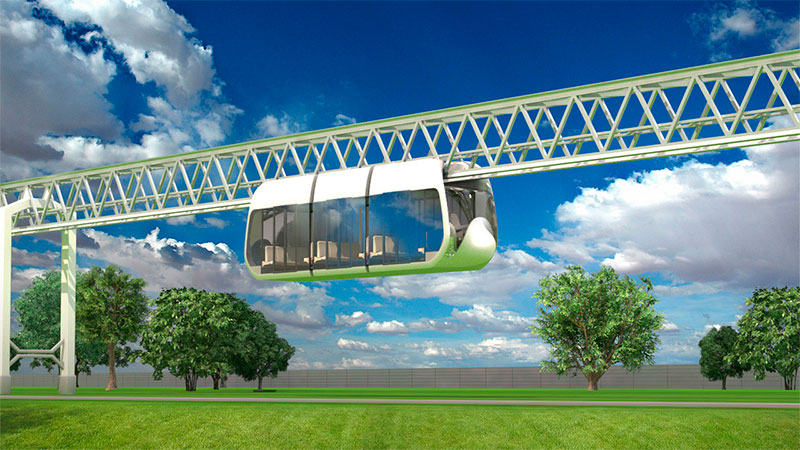
Unitsky String Technologies


 |
Unitsky String Technologies |


|
Site news
|
26 October 2015 |
|
EcoTechnoPark object: urban double-rail unibus - suspended, mounted Urban suspended double-rail unibus is a module suspended passenger wheeled vehicle. The modular principle for unibus construction allows to create both a single vehicle and a compound one (a vehicle consists of several "carriages"), using typical modules. 
The unibus is designed for passenger transportation on urban and suburban routes and it moves on a double-rail track. The train can be assembled from single modules. Unibuses are able to transport over 25,000 passengers per hour at the speed of up to 150 km/h. The capacity of one module for unibus (sitting and standing places) makes from 14 to 28 passengers, depending on execution class. The unibus is designed for operation in different climatic conditions with outside storage. The minimal curve radius, for rounding of which urban double-rail unibus is designed, is as follows: horizontal curve - 15 m, vertical - 50 m. Mounted double-rail unibus moves parallel to the ground along the smooth track at the height of 5-10 m and more, locating above the string truss. It means that unibus moves along top chords of two parallel to each other trusses, which are designed as special rails. Suspended unibus moves in a similar way, just being located under the string truss, therefore lower chords of the truss are also designed as rails. In addition to that, there can be variants for unibus alternate design and string truss for moving on the track with longitudinal grade of up to 30°. The modular principle of unibuses allows flexible adjustment of the transport system for passenger flow ensuring maximal safety and minimal operating and capital costs. All variants of unibus design provide a possibility for physically challenged people and parents with children to travel on the route - the unibus compartments are equipped with places for installation and mounting of wheelchairs and baby strollers. Movement of a double-rail urban unibus is carried out by means of electric traction drive. Electric engines of traction drive are combined with wheels into the single unit - motor-in-wheel, which allows to exclude transmitting units (reducing gears) and, consequently, to reduce dimensions, weight and cost of the drive. The compartment in all double-rail urban unibuses is equipped with the systems of ventilation, air conditioning, lighting, audio and video informing of passengers. Application of double glazing and effective heat insulation allows to reduce heat losses when heating and cooling the compartment, which reduces the cost of ventilation, heating and air conditioning systems. Onboard system for unibus control is fully automatic. It gives control commands to all the mechanisms and systems of the unibus according to the assigned profile of moving on the route. There are subsystems for safety provision, which analyze the track structure condition, the environment in passenger compartment. In case it is necessary, they work out and execute commands on prevention of emergency and hazardous situations. With single unibuses moving as a part of train, onboard control systems combine into the network and control is carried out as for the one vehicle. The unibus developers have carried out a comparative analysis of the suspended unibus and electric automobile Tesla. The analysis has shown that unibus efficiency when moving on the sagging track structure is 17.8 times higher than that of automobile Tesla. Urban double-rail unibus (mounted/suspended) is a unique wheeled vehicle. It is by times more efficient, safer and ecologically friendlier than any other known vehicle - automobile, bus, trolleybus, tram, railway train, plane, air or magnetic cushion train. High consumer properties of the unibus result from a complex of innovative solutions and know-how used for it. For example, its patented aerodynamics is improved compared to a sports car by 5 times; rolling resistance on the rail is decreased compared to the railway pair two-fold. The "second level" of location and anti-derailment system will reduce accident rate compared to, for example, automobile transport approximately by 1,000 times, to name just a few of many advantages. |
|
© 1977—2017 Anatoly Yunitskiy. All Rights Reserved. |
||